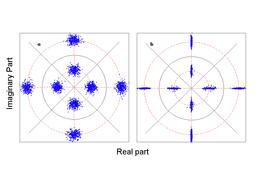All-Optical Phase Regeneration of Fiber Optic Communication Signals
- Started
- 1st December 2012
- Research Team
- Graham Hesketh
- Investigators
- Peter Horak
Fiber optic cables have revolutionized the way we communicate enabling internet usage to grow exponentially. However, current fiber optic technology cannot accommodate indefinite growth. As more information typically requires more power we are soon to be limited by nonlinear noise, a disruptive phenomenon induced by the response of the silica glass fiber to a large electric field. Interestingly however, the same effects that contribute to the noise problem can also remove it. All-optical phase regeneration uses the glass fibers response to high powers to carefully mix additional light with a communication signal in such a way that it cancels all transmission noise in the signals phase, whether it was induced nonlinearly or otherwise.
The figure shows a noisy communication signal carrying phase and amplitude information, before and after all-optical phase regeneration in a highly nonlinear fiber. The phase noise in the angular direction has been squeezed and only amplitude noise in the radial direction remains. Crucially, the phase squeezing has not added to the amplitude noise which was a problem in previous designs.
Together with a team in the laboratory, the Computational Modelling Group in the Optoelectronics Research Centre is reviewing the performance of existing regenerator designs and investigating modifications. Designs are assessed by comparing the bit-error ratio of systems employing the regenerator; reducing the number of erroneous bits of information sent increases the distance over which the signal can be transmitted. Computationally such calculations are notoriously difficult. Light propagation in nonlinear optics is described by a complicated nonlinear partial differential equation and numerically solving it is time consuming, particularly at high powers. Couple this with the number of events required to simulate probability distributions at the required accuracy and simulating each design on a desk top computer could take weeks. With the experimental team investing personnel and valuable equipment time in the project, such time-scales are not practical. To tackle this we utilise multiple computer processors on the iridis supercomputer at the University of Southampton to calculate many simulations in parallel. This reduces the computation time to just a few hours and enable the team to work efficiently. Our simulations indicate that all-optical regeneration can reduce the bit-error ratio in long-haul fiber optic communications by an order of magnitude. This work is meeting the demands made by ever increasing internet traffic and will feature in an upcoming international conference.
Categories
Physical Systems and Engineering simulation: Electromagnetism, Fiber Optic Communications, Photonics, Wave propagation
